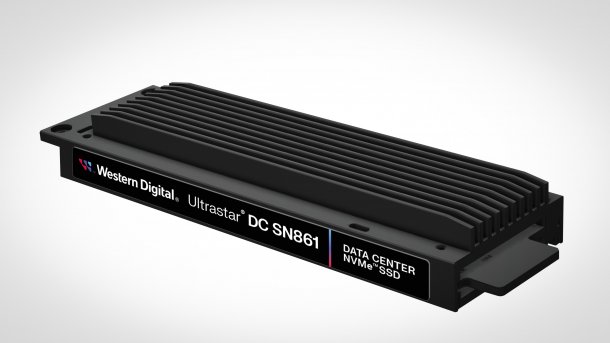Western Digital: SSD with 64 TByte, hard disks with 32 TByte
Nothing works without AI: WD launches new drives designed to facilitate the use of AI potential. Of course, other data can also be stored on them.

The WD SSD Ultrastar DC SN861 in server format E1.S.
(Image: Western Digital)
Away from the Computex IT trade fair, everything revolves around AI: Western Digital is presenting a "six-stage framework for the AI data cycle ". Specifically, this involves a new hard drive and a series of new data center SSDs: The Ultrastar DC SN861 SSD works with PCI Express 5.0 and is available with up to 16 TB of storage space. It uses NVMe version 2.0 and is planned in versions for different write loads. It is already being delivered to some test customers in the E1.S enterprise form factor; the official sales launch will begin in the fall. Western Digital plans to ship the first U.2 versions of the SSD in a 2.5-inch housing in June, and the SSD will also be released as an E3.S version - the company will not publish details on this until later in the year.
The Ultrastar DC SN655 data center SSD provides more storage. It will only be available with a U.3 interface and, with capacities of up to 64 TByte, should be particularly suitable for storage-intensive applications. This SSD is also already being tested by some customers, and WDC intends to announce further details when series production starts later this year.
Videos by heise
Hard disks as AI storage
Hard disks are also intended to serve as inexpensive storage for large volumes of AI data. Western Digital has further upgraded its Datacenter series for this purpose: The DC HC690 has a raw capacity of 32 TByte. The company uses two in-house developments for this: UltraSMR and OptiNAND. UltraSMR is an extended version of Shingled Magnetic Recording (SMR), which is also common in consumer hard disks and is intended to increase capacity by around 20 percent compared to conventional recording technology by overlapping the data tracks.
(Image: Western Digital)
OptiNAND is a very small flash memory compared to the disk capacity, in which some metadata and information on the geometry of the disks are stored. This also ultimately leads to narrower tracks and therefore to a higher capacity.
Western Digital plans to provide further information on the DC HC690 over the course of the summer. Prices for the hard disk and also for the SSDs mentioned above are not yet available.
Empfohlener redaktioneller Inhalt
Mit Ihrer Zustimmung wird hier ein externer Preisvergleich (heise Preisvergleich) geladen.
Ich bin damit einverstanden, dass mir externe Inhalte angezeigt werden. Damit können personenbezogene Daten an Drittplattformen (heise Preisvergleich) übermittelt werden. Mehr dazu in unserer Datenschutzerklärung.
(ll)